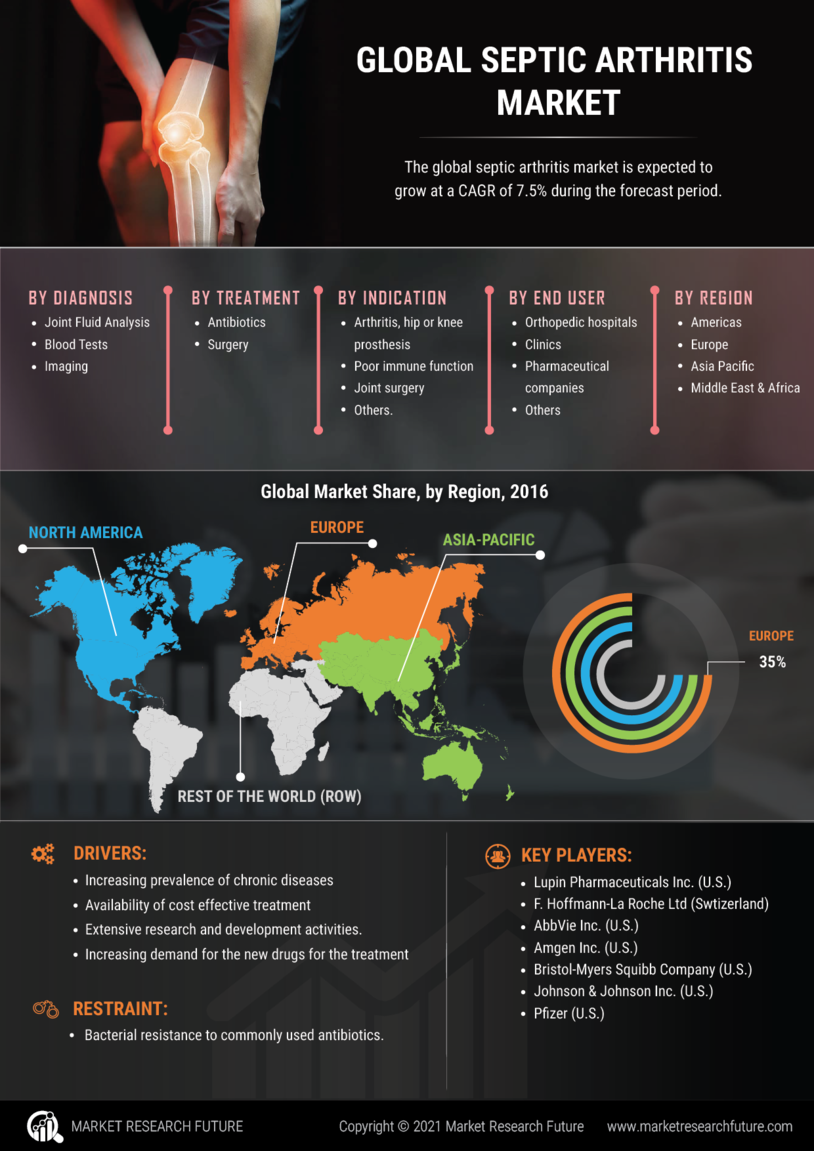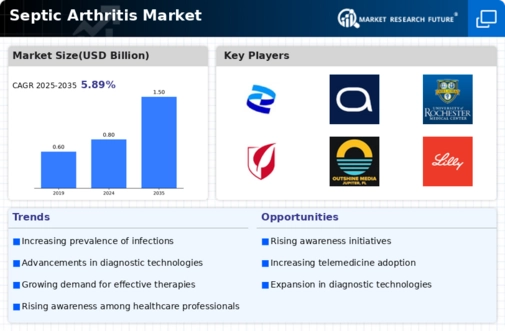Growing Healthcare Expenditure
Growing healthcare expenditure is a critical driver of the Septic Arthritis Market. As countries allocate more resources to healthcare, there is an increased focus on improving patient outcomes and access to advanced treatments. This trend is particularly evident in regions where healthcare systems are evolving to meet the needs of aging populations. Increased funding for healthcare infrastructure and services is likely to enhance the availability of diagnostic tools and treatment options for septic arthritis. Furthermore, as patients become more aware of their treatment options, the demand for specialized care is expected to rise. This shift in healthcare spending priorities may lead to a more robust Septic Arthritis Market, as stakeholders seek to address the growing burden of joint infections.
Rising Prevalence of Septic Arthritis
The increasing prevalence of septic arthritis is a notable driver in the Septic Arthritis Market. Factors such as an aging population and the rise in chronic diseases contribute to this trend. According to recent data, the incidence of septic arthritis has been observed to rise, particularly among older adults and individuals with pre-existing health conditions. This demographic shift is likely to result in a higher demand for effective treatment options and diagnostic services. As healthcare providers become more aware of the condition, the need for innovative therapies and management strategies will likely expand, thereby propelling the growth of the Septic Arthritis Market. Furthermore, the rising number of joint surgeries may also lead to an increase in post-operative infections, further driving the market.
Technological Advancements in Treatment
Technological advancements in treatment modalities are significantly influencing the Septic Arthritis Market. Innovations in surgical techniques, such as minimally invasive procedures, have improved patient outcomes and reduced recovery times. Additionally, the development of novel antibiotics and biologics has enhanced the efficacy of treatment options available for septic arthritis. Recent studies indicate that the introduction of targeted therapies may lead to better management of the condition, thus increasing patient adherence to treatment regimens. As healthcare systems continue to adopt these advanced technologies, the Septic Arthritis Market is expected to experience substantial growth. The integration of telemedicine and digital health solutions also presents opportunities for improved patient monitoring and follow-up care, which could further enhance treatment efficacy.
Rising Awareness and Education Initiatives
Rising awareness and education initiatives are playing a pivotal role in shaping the Septic Arthritis Market. Healthcare organizations and advocacy groups are increasingly focused on educating both healthcare professionals and the public about the signs, symptoms, and risks associated with septic arthritis. Enhanced awareness is likely to lead to earlier diagnosis and treatment, which can significantly improve patient outcomes. Recent campaigns have emphasized the importance of recognizing joint infections and seeking prompt medical attention. As awareness grows, the demand for diagnostic services and treatment options is expected to increase, thereby driving the growth of the Septic Arthritis Market. Additionally, educational programs aimed at healthcare providers may lead to improved clinical practices and better management of septic arthritis cases.
Increased Research and Development Activities
Increased research and development activities are propelling the Septic Arthritis Market forward. Pharmaceutical companies and research institutions are investing significantly in understanding the pathophysiology of septic arthritis, which may lead to the discovery of new therapeutic targets. Recent funding initiatives have been directed towards clinical trials aimed at evaluating the safety and efficacy of emerging treatments. This surge in R&D is likely to result in a pipeline of innovative products that could transform the management of septic arthritis. Moreover, collaborations between academia and industry are fostering a conducive environment for breakthroughs in treatment options. As new therapies emerge, the Septic Arthritis Market is poised for expansion, driven by the demand for more effective and personalized treatment solutions.


















Leave a Comment